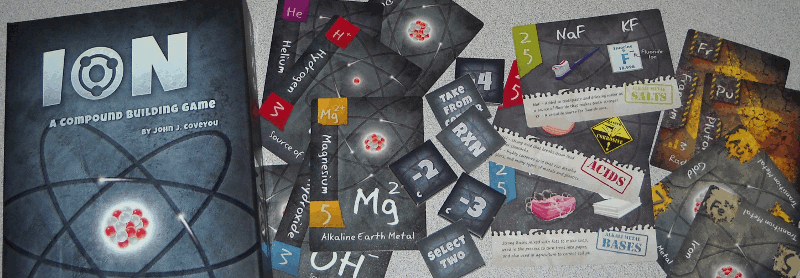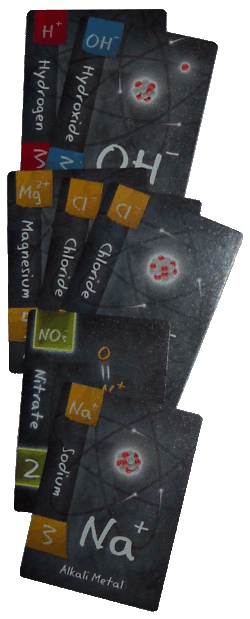
Ion: A Compound Building Game (Review)
by Genius Games


Disclosure
This product was provided to us for the purpose of an honest review. All opinions expressed are our own. This review includes an affiliate link. We may receive a small commission if you click on the link and make a purchase. See our full disclosure for more information.
Overview
Ion: A Compound Building Game is designed for 2 to 7 players ages 8 and up. Players create neutrally charged compounds and sets of noble gases by strategically combining element cards and playing action tiles. Players play simultaneously and exchange cards after every turn, so it's fast-paced and engaging. Prior chemistry knowledge is not required, and cards can be removed to make this game fun for younger players.
Contents
- 103 Cards
- 21 Action Tiles
Price
- $19.95 (at the time of this review)
How to Play
At the start of each round–there are three rounds in all, four unique element cards and two compound cards are placed face up in the center, and each player is dealt eight element cards. (Players are also given a set of three action tiles, but they keep the same tiles for all three rounds.) Simultaneously, players select and play one card from their hands that they believe they can use to form a neutral ionic bond or a set of noble gases and then pass their remaining cards to the player on their right. This continues until there are only two cards left in each player's hand. The action tiles, which give players additional options, such as choosing cards from the center or selecting an extra card from their hands, can be played at any time, but they can cost the players points. Players can earn extra points by forming the compounds on the compound cards, and there are other cards (radioactive, transition metal, and polyatomic ion) with special rules and point values.
By design, there must be at least three players to use the radioactive cards, which, in a nutshell, affect the scoring at the end of each round and again at the end of the game, however, regardless of the number of players, these cards, as well as the transition metal and polyatomic ion cards, could be removed for easier game play. This game can be played with any number of players (probably not more than seven, though, as the rules suggest), but we found that a player's strategy will differ based on how many are playing. For example, in a two player game, after the first exchange, players know what cards they will have to choose from, but when there are more than two players, there is more mystery.
Educational Emphasis
Ion: A Compound Building Game introduces kids to elements, charges, and the concept of ionic bonding. The compound cards teach a little about acids, bases, salts, and gases and include examples of how they are used (such as in toothpaste, soap, fertilizer, and antacids).
The Good
This fast-moving card game is a fun way to introduce chemical elements to kids. With only a select number of elements to choose from, it's not overwhelming for younger players, yet the game play is challenging enough for older players. Here are a few highlights:
- The rules are easy to understand (and there is a YouTube video available should you get stuck).
- Set up is fast.
- It only takes about 20-30 minutes to play.
- Game can be played anywhere.
- Everyone plays at the same time.
- There are separate rules for 3-4 players and 5-7 players, so it's adaptable.
- Certain cards can be removed to make it easier for younger players.
The Not-So-Good
Scoring can be a little confusing at first.
Tips
- Have paper and pencils ready for keeping score.
- Remember to remove the Radioactive cards if there are only 2 players.
- Remove the Radioactive, Polyatomic Ion, and/or Transition Metal cards to make the game easier for younger players.
Recommendation
We believe this game would be a fun addition to your homeschool science curriculum.
Summary
Ion: A Compound Building Game is an adaptable, fast-moving card game that is perfect for introducing the periodic table of elements and the concept of ionic bonding. A little foresight is helpful during game play, but because no prior chemistry knowledge is needed, this game can be enjoyed by all.

